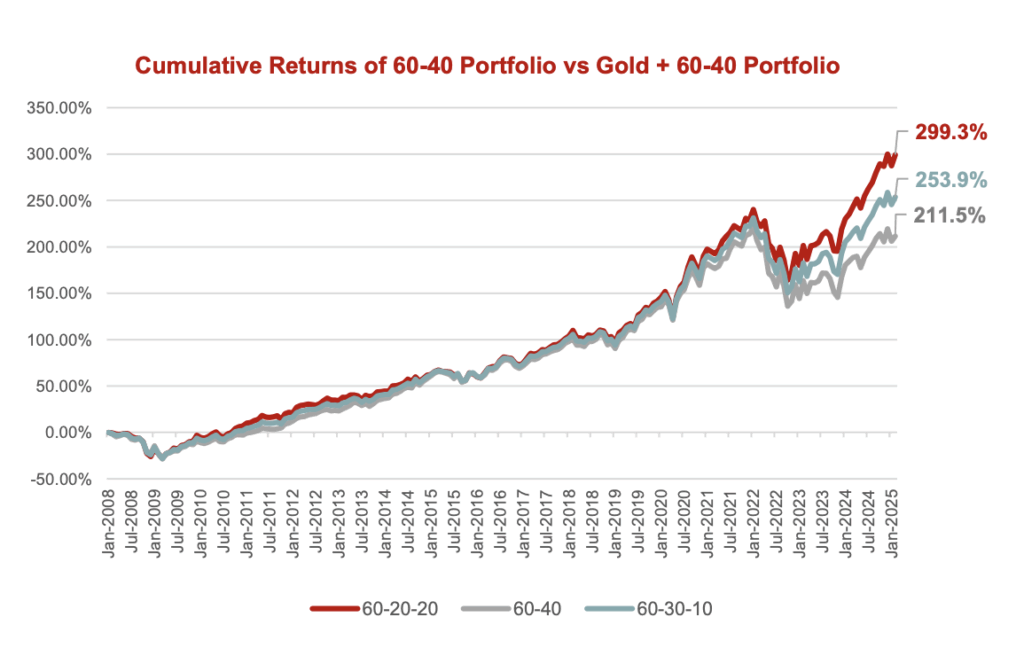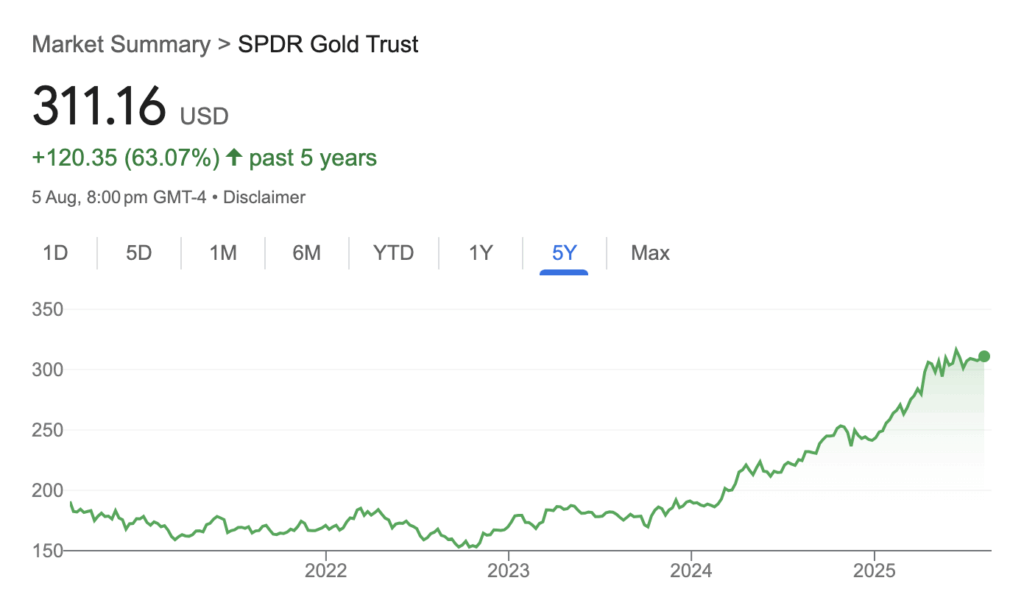
Gold prices have risen almost 54% in the past year, recently breaching the US$4,230/oz mark (as of 16 Oct 2025). Amid economic uncertainty, central bank buying, and expectations of Fed rate cuts, investors are once again turning their attention to gold.
But how exactly does gold fit into a modern investment portfolio, and what’s the best way to gain exposure?
The Role of Gold in a Portfolio
Gold has long been viewed as a safe haven in times of economic stress and market volatility. It serves multiple roles in a portfolio:
- Inflation and recession hedge – Gold historically performs well during inflationary and recessionary periods.
- Safe-haven asset – Demand tends to rise during geopolitical tensions and crises, such as the Russia-Ukraine war or during the COVID-19 pandemic.
- Diversification tool – With low correlation to major asset classes like equities and bonds, gold helps reduce overall portfolio risk.
- Crisis hedge – Gold provides liquidity during financial stress, acting as a store of value when other markets falter.
Gold also plays an established role in multi-asset strategies. For instance, Ray Dalio’s All Weather Portfolio allocates about 7.5% to gold. Similarly, for diversification and downside protection, Syfe’s Core portfolios (Growth, Balanced, and Defensive) allocate 5%–15% in commodities including gold for diversification and downside protection.

Source: Nomura IWM CIO Office, Bloomberg
Adding gold to a 60-40 portfolio has been shown to boost returns and improve risk-adjusted metrics. Incorporating 10%-20% gold into a traditional 60/40 portfolio would result in higher CAGR, Sharpe ratio, while maintaining similar volatility. The chart above compares the returns from a traditional 60-40 portfolio versus one with 20% gold allocation and one with 10%. The one with 20% gold allocation has seen the largest increase in cumulative returns over the past 17 years.
Who Holds Gold?
Central banks remain significant players in the gold market. In recent years, they have accelerated gold purchases as part of a long-term strategy to diversify away from the US dollar and strengthen their reserves.
According to recent data:
- China has been a consistent monthly buyer of gold since late 2022.
- India, the world’s largest gold jewelry market, is seeing rising retail demand.
- Singapore has been adding to its gold reserves as part of MAS’s efforts to maintain a well-diversified and resilient foreign reserve portfolio. It now holds the largest gold reserves in Southeast Asia.
Top gold-holding nations include: the US, Germany, Italy, France, Russia, and China, with Singapore ranking number 19.
Is Now the Time to Hold Gold?
Gold prices have continued to trend higher in 2025, supported by a confluence of macroeconomic and geopolitical factors. As investor sentiment improves, the outlook for gold remains broadly constructive, though not without risks.
What’s working in gold’s favour:
- Lower interest rates ahead
Weaker US jobs data has raised expectations of Fed rate cuts in the second half of 2025. Gold typically performs well when real interest rates are low, as the opportunity cost of holding non-yielding assets falls.
- Central bank demand
Nations like China, India, and Poland continue to accumulate gold, seeking to diversify away from the US dollar. China has been a consistent buyer since late 2022, while India is seeing growing domestic demand through its jewellery market.
- Geopolitical uncertainty
With concerns mounting over China’s deflationary pressures, ongoing sanctions, and economic fragmentation, gold remains a go-to safe haven for investors seeking stability amid rising global risks.
- ETF inflows rebounding
After months of stagnation, gold ETFs saw their strongest inflows since December 2023. Historically, ETF flows have preceded strong gold rallies—a sign that institutional investors are returning to the trade.
What could weigh on gold:
- Short-term consolidation
After surging over 16% year-to-date, gold may experience some consolidation. While the long-term outlook remains bullish, near-term pullbacks are likely as markets reassess rate path and inflation trajectory.
- Rising real yields
As nominal yields increase and inflation moderates, real yields could rise. This would make gold relatively less attractive as it does not offer yields. This remains one of the biggest headwinds to watch.
Source: Bridgewater Associates, March 2025
However, as seen in the chart above, gold has remained resilient even as real yields rise, breaking from its historical pattern. This suggests that demand from central banks and limited supply may now be exerting a stronger influence than in previous cycles.
Tight Supply, Rising Demand
Gold’s price isn’t just driven by market sentiment, but also supported by strong underlying fundamentals. Namely:
- Demand Strength
Gold benefits from steady buying across multiple sectors. Jewellery demand remains robust, especially in India and China, while technology applications continue to use gold in electronics and renewable energy components. Investment demand (through bars, coins, and gold-backed ETFs) has also rebounded, and central banks have been consistently adding to their reserves, with China, India, and Poland leading the way.
- Flat Supply Growth
On the supply side, growth has remained flat. Global mine production has stagnated over the past decade due to rising costs and fewer major discoveries. Recycled gold supply has also been relatively stable.
This tight supply-demand imbalance limits the potential for significant increases in gold availability, even as demand grows, strengthening the long-term outlook for prices.
How to Gain Exposure to Gold
There are multiple ways for investors to tap into gold’s benefits.
1. Physical Gold
Buying gold bars, coins, or jewellery is the most direct way to gain exposure. However, it comes with costs such as:
- Storage and insurance
- Dealer markups
- Less liquidity for small lots
2. Gold ETFs
ETFs offer a low-cost, liquid way to invest in gold without the logistics of buying, storing and insuring gold. When you hold this, you will be essentially holding fractional ownership of the gold bullion in the fund.
SPDR Gold Shares (GLD) is the largest gold-backed ETF globally, with an expense ratio of 0.40%. It has increased 63% in the past five years.

Source: Google Finance, as of 6 Aug 2025
Physical gold ETFs track the spot price of gold closely, making it ideal for long-term portfolio allocations.
3. Gold Futures
Another way investors can gain exposure to gold without investing in physical gold is through futures-based gold ETFs, which are contracts where parties agree to buy and sell gold in the future for a predetermined price.
For the same dollar amount, investors will gain greater exposure to gold in a gold futures ETF than a physical gold ETF. This also applies to potential gains and losses.
Gold futures offer:
- Greater exposure per dollar invested
- Higher potential returns (and risks)
- No need for physical settlement
4. Gold Mining Stocks
Physical gold does not generate a cash flow but gold mining companies do. They may benefit from both rising gold prices and operational efficiency or production growth.
However, miners can underperform if costs rise or operations are mismanaged.
The VanEck Gold Miners ETF (GDX) provides broad exposure to major global miners like Newmont, Barrick Gold, and Franco-Nevada. It comes with a slightly higher expense ratio of 0.51%.
Our Gold Bundle on Syfe Brokerage offers diversified access to the global gold ecosystem, by including physical gold ETFs, major mining firms, and junior gold explorers. It has a 1-year return of 58% and 5-year return of 39%.
Final Thoughts: Is Gold Still a Safe Bet?
As global risks persist and central banks remain net buyers, the long-term case for gold continues to look strong. But while gold has rallied significantly in 2025, it’s important for investors to approach it with a long-term mindset.
Short-term volatility is normal, and price swings—whether driven by shifting Fed expectations, economic data surprises, or geopolitical developments—shouldn’t come as a shock. Gold has historically gone through periods of consolidation even during strong secular bull markets. Investors should avoid reacting emotionally to short-term dips.
Instead, view market pullbacks as strategic entry opportunities. If gold prices dip toward the US$2,800–2,850 range, long-term investors may consider using those levels to accumulate positions gradually. This approach aligns with a constructive but active stance: stay invested, but be tactical and intentional when adding exposure.
Finally, remember that gold works best as part of a broader diversification strategy. Its low correlation with traditional assets makes it a strong complement to equities and bonds, but it doesn’t have to stand alone.
Consider pairing gold with other uncorrelated or counter-cyclical assets to build a more resilient, risk-adjusted portfolio. These could include silver and alternative strategies such as hedge funds, but also income-generating assets like Syfe REIT+ and growth-focused equities (such as Syfe’s Core Equity100) for longer-term capital appreciation. By combining assets with different risk-return profiles, you enhance diversification and increase the chances of weathering various market conditions effectively.
Alternatively, Syfe’s Core portfolios—Growth, Balanced, and Defensive—offer a blend of gold alongside bonds and equities and are professionally managed. Ranging between 5%–15% in gold allocation, these portfolios are perfect for investors seeking diversification and a hands-free approach to growing wealth.



You must be logged in to post a comment.